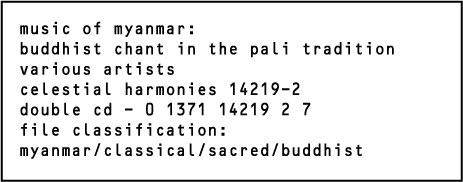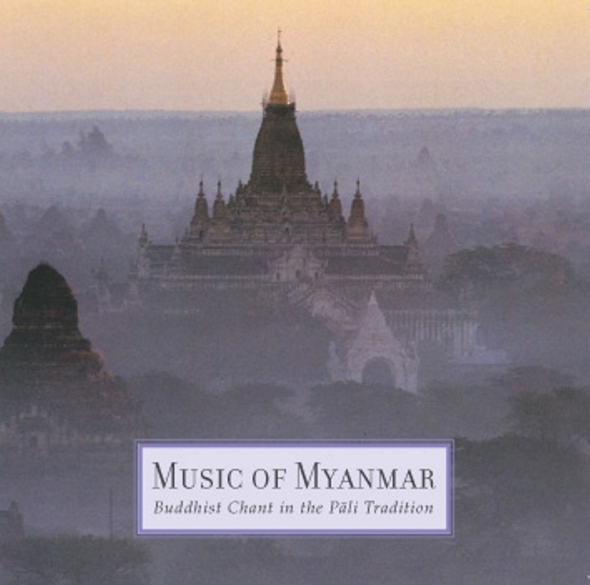 |
|||||||||||||||||||||||||||||||||||||||||||||||||||||||||
 
Myanmar, formerly Burma, is located in the western portion of mainland Southeast Asia. It is bordered by China to the north, Laos and Thailand to the east, the Andaman Sea, Bay of Bengal, Bangladesh and India to the west. Myanmar's culture is an amalgam of folk and royal traditions. The vast majority of the population are Theravada Buddhists, adherants of which accept as authoritative the Pali canon of ancient Indian Buddhism. They trace their lineage back to the Sthaviras (Pali: Theras; Elders), who followed in the the tradition of the first Buddhist sangha. Burmese chronicles and Therevada Buddhist traditions maintain that soon after Lord Buddha passed away and entered Nibbana, two Mon merchants from Lower Burma brought hair relics from India and enshrined them in a small temple. This later became the core over which the great Shwedagon pagoda was built. To this day, its golden spire dominates Yangon (Rangoon), the capital of the country. The maha paritta (the great protection spells) are believed to ward off danger, misfortune and sickness. As exorcism formulas or Buddhist protecting charms they are recited to banish the influence of evil powers. As sacred texts with asseverations of truth they are believed to include tremendous power when they are recited with purity of intention and mindfulness. Each chant is of specific use and any of them can be recited to arouse protection. They can only be rendered ineffectual by the obstructive power of evil Kamma. In the Pali canon and in the commentaries, the use of the paritta by the Buddha himself and his followers is already mentioned. In the Milindapanha (Questions of King Milinda) the Indo-Greek king Menander of Bactria (who ascended the throne c 160 B.C.E.) discusses the use of the paritta with the monk Nagasena. In the chronicles of Ceylon, danger and disease are repeatedly dispelled by the power of the paritta. Possibly the Catubhanavarapali (four recitals), the Singalese selection of some 30 parittas, had already been arranged by the members of the first Buddhist council, which took place in Rajagriha soon after Lord Buddha (460-480 B.C.E. or according to recent research possibly about 100 years later) had passed away. Or they may have been put together by a venerable monk not much later. Almost simultaneously with the introduction of Buddhism, the parittas reached Myanmar. From the Singalese collection 11 suttas formed the score of the Burmese version, which became the best known Pali book in the country. In Burma the Pyu kings had already engraved paritta texts at the city gates to protect their towns from danger. In Sriksetra (Old Prome) parittas are shown in two stone inscriptions from the 5th - 6th century C.E.: fragments of the mora and mangala sutta on the main city gate, and parts of the ratana sutta near the north-western city gate. In records of the Burmese kings we find many hints as to the use of the paritta, chiefly in connection with royal ceremonies like coronations, weddings, victory celebrations, or the inauguration of a new palace. We know that King Kyanzittha of Pagan (1084-1113 C.E.) invited 4,108 monks to recite parittas while his royal palace was built. The oldest available paritta texts in Burma are entitled parittavanna and date from 1609 C.E. That parittas were still very popular during the 19th century shows the high number of paritta nissayas (explanations) of that time. During British rule (1886-1946) the chanting of parittas declined. Nowadays they are very popular again. We find several different collections according to preferences of the compilers. The parittas are not a separate book in the Pali canon but an anthology of suttas culled from the five Nikayas (collections). Several of the parittas show the strong influence of Mahayana and Tantric Buddhism as well as Brahmic lore. They are recited by monks, novices and lay people in temples and houses to ceremonially ward off evil and bring good luck. Even today, pious Buddhist lay people in Burma recite parittas almost daily. Conflicts, dangerous situations, natural disasters, diseases and many other calamaties are believed to stem from karmic causes or supranatural resources. The chanting of maha paritta is believed to evoke great power and to generate helpful spiritual forces capable of counteracting unfortunate occurrences. While reciting, the devotees are not particularly expected to understand the meaning of the words they utter. Rather, if the sound is well-directed and the vibrations are converted into words of power, they can ward off evil and bring good luck for the protection and welfare of beings. The doctrine of conditional relations, this most sacred and sublime Pali text we find the last book of Abhidhamma Pitaka, entitled patthana pakarana. Its recitation is believed to give a special protection, for example, for soldiers against being killed in battle. Its subject is causation, the backbone of Buddhist teaching. Casual relations explain the functioning of the universe with its living beings, their bondage and the means of release. Patthana explains causation in minute detail. In Myanmar the 24 modes of relationship (with the groups of causes and effects) often are arranged in a flower with 24 petals as an aid to memorization. Listening to the melody of the song Te3 Bhumma (Three Worlds) one would not expect it to contain such erudite religious philiosophical lyrics on Buddhist doctrine in such a highly condensed form. This song was written and composed by the Burmese polyhistorian U Pyone Cho (1878-1927), one of the most learned scholars to emerge from Burma following British annexation in 1885. The extent of this scholar's knowledge and sphere of interests earned him the epithet Myanmar's Leonardo da Vinci among his contemporaries. Not only was he an extremely gifted fine artist, he also possessed a great talent for the natural sciences. Hawsa is a recitation of a religious story in verse. Although it is performed by only one person it shows dialogue form: the reciter changes his voice and uses dramatic gestures. Today in Burma only very few of the reciters—in many cases accomplished verse writers or even poets—can be found. As they were learned persons and knew Pali they have always been highly respected, in contrast to actors, who were looked upon like beggars. This double CD was recorded in Yangon (Rangoon), Myanmar in 2000 and 2001. It is accompanied by a beautiful 92 page booklet containing the prayers in Pali, Burmese and English. the producerProf. Dr. Gretel Schwörer-Kohl was born in Karlsruhe, Germany.
She started to study the piano at the Musikhochschule in Freiburg
in 1970 and musicology at the university in the same city. In
1972 she moved to Cologne and at the university there as additional
subjects took art history and anthropology. In 1974 she attended
lectures in philosophy and Thai language at the university in
Hamburg and from 1974-76 lessons on Thai music at Silapakhorn
university in Bangkok. During the two years in Thailand she also
went out for field work to collect musical instruments and to
record music among the hill tribes in Northern Thailand. In 1980
she finished her dissertation on The mouth organ of the Lahu
people in Northern Thailand. Since 1993 she has been studying
the music of Myanmar and in 1998 submitted her habilitation on
The ceremonial music for the 37 nat-spirits in Myanmar/Burma.
Her special interest is devoted to the music of Southeast Asia
mainly in its ritual context and to the different types of mouth
organs in East- and Southeast-Asia. Since 1999 as a professor
for ethnomusicology she is teaching at the department of musicology
of the Martin-Luther-Luther-University in Halle. Prof. Dr. Gretel Schwörer-Kohl tracklist
|
|||||||||||||||||||||||||||||||||||||||||||||||||||||||||
|
|
|||||||||||||||||||||||||||||||||||||||||||||||||||||||||
 |


